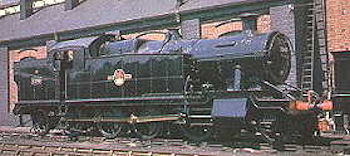|
|
|
7200 tank class introduction
Running numbers: 7200 - 7253.
Built: 1934 (7200 - 7219) to lot number 266,
1935-36 (7220 - 7239) to lot number 233,
1937-39 (7240 - 7253) to lot number 318.
The 2 - 8 - 2 tank was first envisaged in Churchwards Standardisation Plan of 1906 but due to fears that the locomotives would not be able to cope with the sharp curves found in the Welsh railway system, it was not built. In response to this, the '4200' 2 - 8 - 0 tanks were constructed instead.
As described in the introduction to the '4200' class, a decline in coal traffic resulted in several of this class lying idle awaiting work as their small coal bunkers precluded them from being utilised on other duties. Therefore Charles Collett rebuilt some members of the '4200' and '5205' classes to a 2 - 8 - 2T configuration to extend their working range.
The first engine modified was number 5277 which became number 7200. The frames were lengthened by 4 feet 1 inch so as to include a trailing pony truck and to increase the coal and water capacity from 4 tons and 1,800 gallons to 6 tons and 2,500 gallons respectively. The next 19 engines of the class were rebuilt from the number 5275 - 5294 series ,which were being held in store at Swindon. modified was number 5277 which became number 7200. The frames were lengthened by 4 feet 1 inch so as to include a trailing pony truck and to increase the coal and water capacity from 4 tons and 1,800 gallons to 6 tons and 2,500 gallons respectively. The next 19 engines of the class were rebuilt from the number 5275 - 5294 series ,which were being held in store at Swindon.
When the Operating Department were impressed by the success of these rebuilds, another twenty were ordered in 1935, to be modified from the number 5255 - 5274 series. Again, in 1937, more of these rebuilds were ordered, however, the 2 - 8 - 0Ts used for this batch of 14 locomotives were from the old '4200' class and required a more extensive rebuild including the fitment of new cylinders to the later 19 inch diameter standard. A decision was taken to slightly alter the coal and water capacities of this 7240 to 7253 batch which became 5 tons and 2,700 gallons respectively and the engines used for these rebuilds were 4239 / 4220 / 4202 / 4204 / 4216 / 4205 / 4234 / 4244 / 4249 / 4209 / 4219 / 4240 / 4210 and 4245.
Although the class were generally successful, the engines were known to be 'curve shy' due to the length of the wheelbase, and because they became derailed in Banbury Yard so often, many sidings were put out of bounds to them.
Withdrawal.
The first member of the class to be withdrawn was number 7241 in November 1962 whilst the last four engines in traffic served until June 1965.
Preservation.
Three engines are now preserved, numbers being 7200, 7202 and 7229.
Specifications.
|
|
|
|
|
|
|
Cylinders |
(2) 19 x 30 inches |
Driving wheel diameter |
4 feet 7½ inches |
|
|
Bogie / Trailing wheel dia |
3 feet 2 in / 3 feet 8 in |
Tractive Effort |
33,170 pounds |
|
|
Boiler type |
Number 4 |
Boiler maximum dia. |
5 feet 6 inches |
|
|
Boiler minimum dia. |
4 feet 10¾ inches |
Fire tubes, no. and dia. |
235 x 1 5/8 inches |
|
|
Flue tubes, no. and dia. |
14 x 5 1/8 inches |
Superheater tubes, no. and dia. |
84 x 1 inch |
|
|
Boiler pressure |
200 lbs/square inch. |
Boiler length |
11 feet 0 inches |
|
|
Area of firegrate |
20.56 square feet |
Heating surfaces, tubes |
1,349.64 square feet |
|
|
Heating surfaces, firebox |
128.72 square feet |
Heating surfaces, superheater |
191.88 square feet |
|
|
Length |
44 ft 10 in |
Total Weight |
92 tons 12 cwt |
|
|
Water Capacity |
2500 gallons |
Coal Capacity |
6 tons |
|
|
G.W. Power Class |
E |
Route Availability |
Red |
|
|
BR Power Classification |
8-F |
|
|
|
Copyright © by John Daniel 2013.
|

 modified was number 5277 which became number 7200. The frames were lengthened by 4 feet 1 inch so as to include a trailing pony truck and to increase the coal and water capacity from 4 tons and 1,800 gallons to 6 tons and 2,500 gallons respectively. The next 19 engines of the class were rebuilt from the number 5275 - 5294 series ,which were being held in store at Swindon.
modified was number 5277 which became number 7200. The frames were lengthened by 4 feet 1 inch so as to include a trailing pony truck and to increase the coal and water capacity from 4 tons and 1,800 gallons to 6 tons and 2,500 gallons respectively. The next 19 engines of the class were rebuilt from the number 5275 - 5294 series ,which were being held in store at Swindon. 